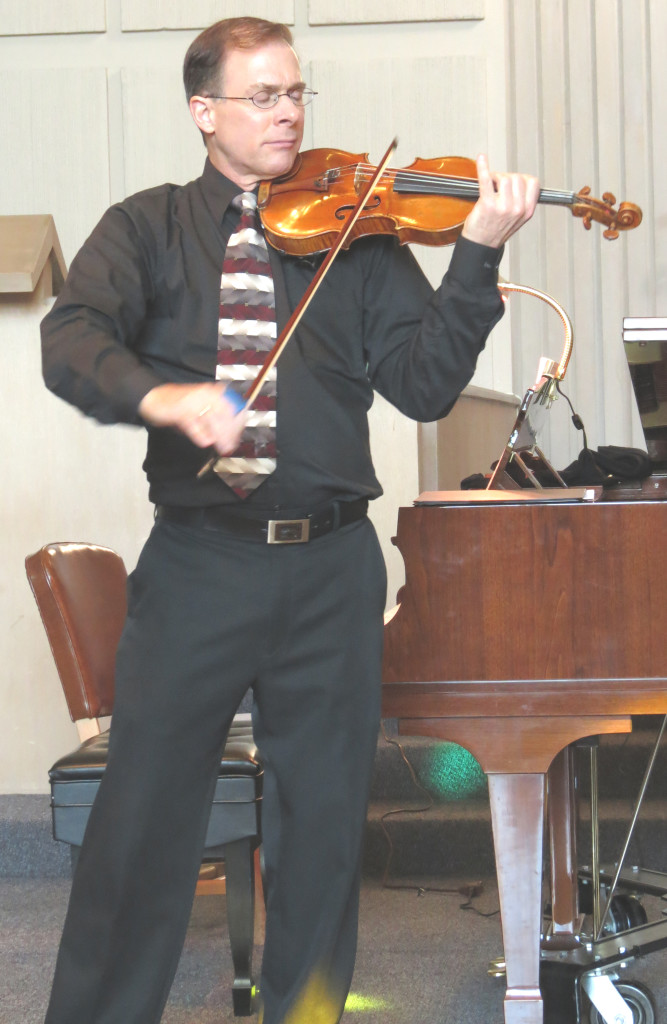
FRANKLYN D’ANTONIO performed Sunday at First Presbyterian Church of Vallejo, a recital presented by Vallejo Symphony Orchestra.
Theresa D. Gabel photo
The concert got under way quickly. Vallejo Symphony publicist Tim Zumwalt made a brief introduction — all that was required for the room full of classical music aficionados — and D’Antonio likewise wasted no time with small talk, diving right into the first selection, “The Chaconne,” by Johann Sebastian Bach.
“The Chaconne” is a movement from Bach’s famous violin partita No. 2. Chaconne as a musical form was originally a suggestive dance accompanied by castanets, as described by Dictionary.com:
“Originally a fiery and suggestive dance that appeared in Spain about 1600 and eventually gave its name to a musical form. Apparently danced with castanets by a couple or by a woman alone, it soon spread to Italy, where it was considered disreputable as it had been in Spain.”
Wikipedia adds: “The chaconne fell into decline during the 19th century, though the ‘32 Variations in C Minor’ by Beethoven suggest its continuing influence. The form saw a very substantial revival during the 20th century, with more than two dozen composers contributing examples.”
According to the concert program notes, the Chaconne covers every aspect of violin playing known during Bach’s time and is considered one of the most technically and musically demanding pieces ever written for violin. D’Antonio’s performance of the piece for solo violin was flawless, spirited and energized.
What came through in listening, though, was not a sprint through a maze of technique but rather a rollicking ride through exciting terrain. The sounds produced were at turns rasping and angry or soft and lovely — high-speed or almost leisurely — evoking scenes of majesty, like a forest that is breathtakingly beautiful yet also frightening.
The second musical selection Sunday was the “Violin Sonata in E-flat Major, Op.18,” by Richard Strauss. Pianist Graber, currently staff accompanist at both San Domenico and San Francisco conservatories, provided exquisite accompaniment to the far mellower and romantic sonata.
Listeners could easily imagine a celebration at a royal court of the latter 19th century. Simple piano chords bounced like raindrops as the melodic violin danced sprightly above them, creating a relaxed but jovial mood. Interludes within the piece were stunningly beautiful but not overpowering, and upon closer listening one could discern a subtle spirit of camaraderie and mutual encouragement between the two musicians, who have played together often.
After a brief intermission, D’Antonio returned to the stage to perform another chaconne, “Lachen Verlernt,” or “Laughing Unlearned,” by Esa-Pekka Salonen. The violinist considers the work to be one of the most difficult he has taken on. “It was as difficult to memorize as it was to execute,” D’Antonio told The Herald in a pre-concert interview last week.
The piece follows the structure of a chaconne but with such extensive and contorted variations on its theme that one can see why it would be challenging for a musician to memorize. It was interesting to me that of all the feelings and visions that “Lachen” elicited in my imagination, laughter was not among them — it came across as a decidedly serious piece.
Similar to the Bach chaconne in its rhythm and in its progression between peaceful and angry passages, the turns in “Lachen” are more stark and brisk. If the Bach piece could be likened to a carriage ride through a forest, then Salonen’s would be more of a raft trip down a raging river: The scenery and energy may fluctuate, but it all goes by very quickly and it’s over very soon.
Sunday’s concert concluded with a cheerful selection, an arrangement of songs from Leonard Bernstein’s “West Side Story,” arranged for violin and piano by David Newman, titled simply “West Side Story Suite.” Songs from the familiar musical were easy enough to recognize, but the piece is so lovely on its own merit that the familiar melodies ended up taking second chair to the unified and happy composite.
Notably, that distinct camaraderie that was so apparent in the musicians’ first duo of the afternoon was even more apparent here, each instrument frolicking with assertive beats and melodies as if responding to one another in a celebratory dance. That happy conclusion allowed the audience to leave with a feeling of refreshed spirit.
A great musical performance can inspire the spirit in unique ways, and this offering from the Vallejo Symphony was a fine example of just that.
The Symphony itself will be back in action next on May 10 at the Hogan Auditorium in Vallejo, presenting Handel’s “Water Music” and “A German Requiem” by Brahms. Featured guests will be soprano Lauren Woody and bass/baritone Paul Cheak.
For more information call the symphony office at 707-643-4441 or visit vallejosymphony.org.
Elizabeth Warnimont is a freelance writer specializing in the performing arts. She is also a substitute teacher for the Benicia Unified School District.






Leave a Reply